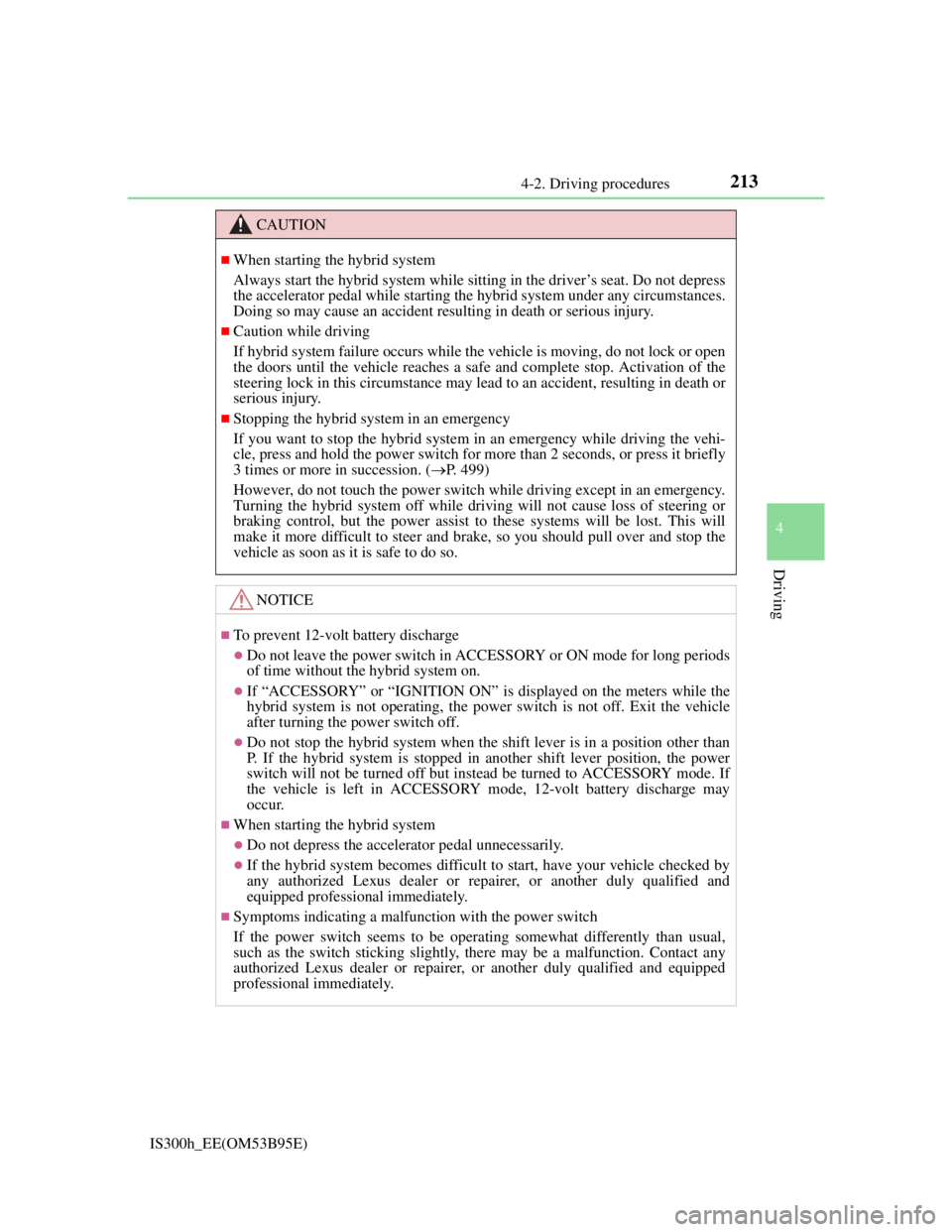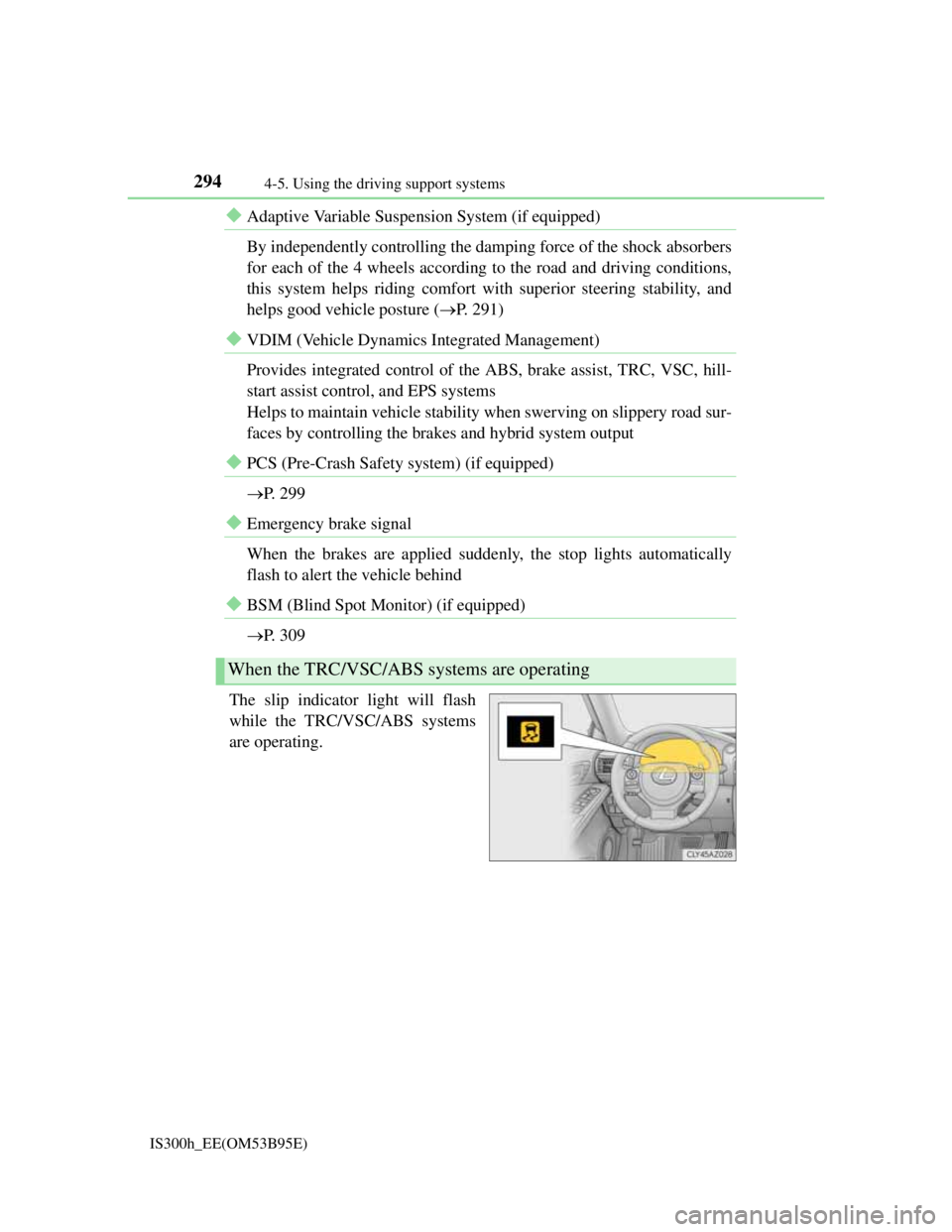stop start Lexus IS300h 2013 Owner's Guide
[x] Cancel search | Manufacturer: LEXUS, Model Year: 2013, Model line: IS300h, Model: Lexus IS300h 2013Pages: 628, PDF Size: 20.23 MB
Page 208 of 628

2064-1. Before driving
IS300h_EE(OM53B95E)
Your vehicle will handle differently when towing a trailer. In order to
avoid accident, death or serious injury, keep the following in mind when
towing:
Checking connections between trailer and lights
Stop the vehicle and check the operation of the connection between the
trailer and lights after driving for a brief period as well as before start-
ing off.
Practicing driving with a coupled trailer
Get the feel for turning, stopping and reversing with the trailer cou-
pled by practicing in an area with no or light traffic.
When reversing with a coupled trailer, hold the section of the steer-
ing wheel nearest to you and rotate clockwise to turn the trailer left
or counterclockwise to turn it right. Always rotate a little at a time to
prevent steering error. Have someone guide you when reversing to
lessen the risk of an accident.
Increasing vehicle-to-vehicle distance
At a speed of 10 km/h (6 mph), the distance to the vehicle running
ahead of you should be equivalent to or greater than the combined
length of your vehicle and trailer. Avoid sudden braking that may cause
skidding. Otherwise, the vehicle may spin out of control. This is espe-
cially true when driving on wet or slippery road surfaces.
Sudden acceleration/steering input/cornering
Executing sharp turns when towing may result in the trailer colliding
with your vehicle. Decelerate well in advance when approaching turns
and take them slowly and carefully to avoid sudden braking.
Important points regarding turning
The wheels of the trailer will travel closer to the inside of the curve
than the wheels of the vehicle. To make allowance for this, take the
turns wider than you would normally do.
Guidance
Page 209 of 628

2074-1. Before driving
4
Driving
IS300h_EE(OM53B95E)
Important points regarding stability
Vehicle movement resulting from uneven road surfaces and strong
crosswinds will affect handling. The vehicle may also be rocked by
passing buses or large trucks. Frequently check behind when moving
alongside such vehicles. As soon as such vehicle movement occurs,
immediately start to decelerate smoothly by slowly applying the
brakes. Always steer the vehicle straight ahead while braking.
Passing other vehicles
Consider the total combined length of your vehicle and trailer and
ensure that the vehicle-to-vehicle distance is sufficient before execut-
ing lane changes.
Transmission information
To maintain engine braking efficiency, when using engine braking
when driving on a long steep downward grade, do not use the transmis-
sion in D. The vehicle must be driven in gear shift position “4” in S
mode. (P. 219)
If the engine overheats
Towing a loaded trailer up a long, steep incline in temperatures exceed-
ing 30C (85F) may result in the engine overheating. If the engine
coolant temperature gauge indicates that the engine is overheating, turn
the air conditioning off immediately, leave the road and stop the vehi-
cle in a safe place.
(P. 555)
When parking the vehicle
Always place wheel chocks under the wheels of both the vehicle and
trailer. Firmly set the parking brake and shift the shift lever to P.
Page 213 of 628

2114-2. Driving procedures
4
Driving
IS300h_EE(OM53B95E)
If the hybrid system is stopped with the shift lever in a position other than
P, the power switch will not be turned off but instead be turned to
ACCESSORY mode. Perform the following procedure to turn the switch
off:
Check that the parking brake is set.
Shift the shift lever to P.
Check that “Turn Power OFF” is displayed on the multi-information
display and then press the power switch once.
Check that “Turn Power OFF” on the multi-information display is off.
Auto power off function
If the vehicle is left in ACCESSORY mode for more than 20 minutes or ON
mode (the hybrid system is not operating) for more than an hour with the shift
lever in P, the power switch will automatically turn off. However, this function
cannot entirely prevent 12-volt battery discharge. Do not leave the vehicle with
the power switch in ACCESSORY or ON mode for long periods of time when
the hybrid system is not operating.
Sounds and vibrations specific to a hybrid vehicle
P. 8 2
Electronic key battery depletion
P. 133
When the ambient temperature is low, such as during winter driving conditions
It may take time before the “READY” indicator comes on.
Conditions affecting operation
P. 151
Notes for the entry function
P. 152
If the hybrid system does not start
Check that the shift lever is securely set in P. The hybrid system may not start if
the shift lever is displaced out of P.
The immobilizer system may not have been deactivated. (P. 90)
Contact any authorized Lexus dealer or repairer, or another duly qualified and
equipped professional.
When stopping the hybrid system with the shift lever in a position
other than P
1
2
3
4
Page 215 of 628

2134-2. Driving procedures
4
Driving
IS300h_EE(OM53B95E)
CAUTION
When starting the hybrid system
Always start the hybrid system while sitting in the driver’s seat. Do not depress
the accelerator pedal while starting the hybrid system under any circumstances.
Doing so may cause an accident resulting in death or serious injury.
Caution while driving
If hybrid system failure occurs while the vehicle is moving, do not lock or open
the doors until the vehicle reaches a safe and complete stop. Activation of the
steering lock in this circumstance may lead to an accident, resulting in death or
serious injury.
Stopping the hybrid system in an emergency
If you want to stop the hybrid system in an emergency while driving the vehi-
cle, press and hold the power switch for more than 2 seconds, or press it briefly
3 times or more in succession. (P. 499)
However, do not touch the power switch while driving except in an emergency.
Turning the hybrid system off while driving will not cause loss of steering or
braking control, but the power assist to these systems will be lost. This will
make it more difficult to steer and brake, so you should pull over and stop the
vehicle as soon as it is safe to do so.
NOTICE
To prevent 12-volt battery discharge
Do not leave the power switch in ACCESSORY or ON mode for long periods
of time without the hybrid system on.
If “ACCESSORY” or “IGNITION ON” is displayed on the meters while the
hybrid system is not operating, the power switch is not off. Exit the vehicle
after turning the power switch off.
Do not stop the hybrid system when the shift lever is in a position other than
P. If the hybrid system is stopped in another shift lever position, the power
switch will not be turned off but instead be turned to ACCESSORY mode. If
the vehicle is left in ACCESSORY mode, 12-volt battery discharge may
occur.
When starting the hybrid system
Do not depress the accelerator pedal unnecessarily.
If the hybrid system becomes difficult to start, have your vehicle checked by
any authorized Lexus dealer or repairer, or another duly qualified and
equipped professional immediately.
Symptoms indicating a malfunction with the power switch
If the power switch seems to be operating somewhat differently than usual,
such as the switch sticking slightly, there may be a malfunction. Contact any
authorized Lexus dealer or repairer, or another duly qualified and equipped
professional immediately.
Page 295 of 628

2934-5. Using the driving support systems
4
Driving
IS300h_EE(OM53B95E)
ABS (Anti-lock Brake System)
Helps to prevent wheel lock when the brakes are applied suddenly, or if
the brakes are applied while driving on a slippery road surface
Brake assist
Generates an increased level of braking force after the brake pedal is
depressed when the system detects a panic stop situation
VSC (Vehicle Stability Control)
Helps the driver to control skidding when swerving suddenly or turn-
ing on slippery road surfaces
VSC+ (Vehicle Stability Control+)
Provides cooperative control of the ABS, TRC, VSC and EPS.
Helps to maintain directional stability when swerving on slippery road
surfaces by controlling steering performance.
TRC (Traction Control)
Helps to maintain drive power and prevent the drive wheels from spin-
ning when starting the vehicle or accelerating on slippery roads
Hill-start assist control
Prevents the vehicle from rolling backward when starting on an incline
or slippery slope
EPS (Electric Power Steering)
Employs an electric motor to reduce the amount of effort needed to
turn the steering wheel
Driving assist systems
To help enhance driving safety and performance, the following systems
operate automatically in response to various driving situations. Be aware,
however, that these systems are supplementary and should not be relied
upon too heavily when operating the vehicle.
Page 296 of 628

2944-5. Using the driving support systems
IS300h_EE(OM53B95E)
Adaptive Variable Suspension System (if equipped)
By independently controlling the damping force of the shock absorbers
for each of the 4 wheels according to the road and driving conditions,
this system helps riding comfort with superior steering stability, and
helps good vehicle posture (P. 291)
VDIM (Vehicle Dynamics Integrated Management)
Provides integrated control of the ABS, brake assist, TRC, VSC, hill-
start assist control, and EPS systems
Helps to maintain vehicle stability when swerving on slippery road sur-
faces by controlling the brakes and hybrid system output
PCS (Pre-Crash Safety system) (if equipped)
P. 2 9 9
Emergency brake signal
When the brakes are applied suddenly, the stop lights automatically
flash to alert the vehicle behind
BSM (Blind Spot Monitor) (if equipped)
P. 3 0 9
The slip indicator light will flash
while the TRC/VSC/ABS systems
are operating.
When the TRC/VSC/ABS systems are operating
Page 298 of 628

2964-5. Using the driving support systems
IS300h_EE(OM53B95E)
When the 12-volt battery is disconnected
The steering wheel may move from its straight forward position, but this will be
corrected automatically when driving.
Sounds and vibrations caused by the ABS, brake assist, TRC, VSC, hill-start
assist control systems
A sound may be heard from the engine compartment when the brake pedal is
depressed repeatedly, when the hybrid system is started or just after the vehicle
begins to move. This sound does not indicate that a malfunction has occurred in
any of these systems.
Any of the following conditions may occur when the above systems are operat-
ing. None of these indicates that a malfunction has occurred.
• Vibrations may be felt through the vehicle body and steering.
• A motor sound may be heard after the vehicle comes to a stop.
EPS operation sound
When the steering wheel is operated, a motor sound may be heard. This does not
indicate a malfunction.
Reactivation of the TRC/VSC systems
Even after the TRC/VSC systems have been turned off, turning the hybrid sys-
tem off and then on again will automatically reactivate the TRC/VSC systems.
Reactivation of the TRC system linked to vehicle speed
When only the TRC system is turned off, the TRC system will turn on when
vehicle speed increases. However, when both TRC and VSC systems are turned
off, the systems will not turn on even when vehicle speed increases.
Reduced effectiveness of the EPS system
The effectiveness of the EPS system is reduced to prevent the system from over-
heating when there is frequent steering input over an extended period of time.
The steering wheel may feel heavy as a result. Should this occur, refrain from
excessive steering input or stop the vehicle and turn the hybrid system off. The
EPS system should return to normal within 10 minutes.
Page 299 of 628

2974-5. Using the driving support systems
4
Driving
IS300h_EE(OM53B95E)
Operating conditions of hill-start assist control
When the following four conditions are met, the hill-start assist control will oper-
ate:
The shift lever is in a position other than P or N (when starting off forward/
backward on an upward incline).
The vehicle is stopped.
The accelerator pedal is not depressed.
The parking brake is not engaged.
Automatic system cancelation of hill-start assist control
The hill-start assist control will turn off in any of the following situations:
The shift lever is moved to P or N.
The accelerator pedal is depressed.
The parking brake is engaged.
Approximately 2 seconds elapse after the brake pedal is released.
Operating conditions of emergency brake signal
When the following three conditions are met, the emergency brake signal will
operate:
The emergency flashers are off.
Actual vehicle speed is over 55 km/h (35 mph).
The brake pedal is depressed in a manner that cause the system to judge from
the vehicle deceleration that this is a sudden braking operation.
Automatic system cancelation of emergency brake signal
The emergency brake signal will turn off in any of the following situations:
The emergency flashers are turned on.
The brake pedal is released.
The system judges from the vehicle deceleration that is not a sudden braking
operation.
Page 300 of 628

2984-5. Using the driving support systems
IS300h_EE(OM53B95E)
CAUTION
The ABS does not operate effectively when
The limits of tire gripping performance have been exceeded (such as exces-
sively worn tires on a snow covered road).
The vehicle hydroplanes while driving at high speed on wet or slick roads.
Stopping distance when the ABS is operating may exceed that of normal condi-
tions
The ABS is not designed to shorten the vehicle’s stopping distance. Always
maintain a safe distance from the vehicle in front of you, especially in the fol-
lowing situations:
When driving on dirt, gravel or snow-covered roads
When driving with tire chains
When driving over bumps in the road
When driving over roads with potholes or uneven surfaces
TRC may not operate effectively when
Directional control and power may not be achievable while driving on slippery
road surfaces, even if the TRC system is operating.
Drive the vehicle carefully in conditions where stability and power may be lost.
Hill- start assist control does not operate effectively when
Do not overly rely on hill-start assist control. Hill-start assist control may not
operate effectively on steep inclines and roads covered with ice.
Unlike the parking brake, hill-start assist control is not intended to hold the
vehicle stationary for an extended period of time. Do not attempt to use hill-
start assist control to hold the vehicle on an incline, as doing so may lead to an
accident.
When the VSC is activated
The slip indicator light flashes. Always drive carefully. Reckless driving may
cause an accident. Exercise particular care when the indicator light flashes.
When the TRC/VSC systems are turned off
Be especially careful and drive at a speed appropriate to the road conditions. As
these are the systems to ensure vehicle stability and driving force, do not turn
the TRC/VSC systems off unless necessary.
Replacing tires
Make sure that all tires are of the specified size, brand, tread pattern and total
load capacity. In addition, make sure that the tires are inflated to the recom-
mended tire inflation pressure level.
The ABS, TRC and VSC systems will not function correctly if different tires
are installed on the vehicle.
Contact any authorized Lexus dealer or repairer, or another duly qualified and
equipped professional for further information when replacing tires or wheels.
Handling of tires and the suspension
Using tires with any kind of problem or modifying the suspension will affect
the driving assist systems, and may cause a system to malfunction.
Page 421 of 628

4076-1. Using the air conditioning system
6
Interior features
IS300h_EE(OM53B95E)
Registering air conditioning settings to electronic keys (vehicles with driving
position memory)
Unlocking the vehicle using an electronic key and turning the power switch to
ON mode will recall that key’s registered air conditioning settings.
When the power switch is turned off, the current air conditioning settings will
automatically be registered to the electronic key that was used to unlock the
vehicle.
The system may not operate correctly if more than one electronic key is in the
vicinity or if the smart entry & start system is used to unlock a passenger door.
The doors that can recall the air conditioning setting when unlocked using the
smart entry & start system can be changed.* For details, contact any authorized
Lexus dealer or repairer, or another duly qualified and equipped professional.
*: The doors that can recall the driving position memory are changed at the same
time.
Using automatic mode
Fan speed is adjusted automatically according to the temperature setting and the
ambient conditions.
Therefore, the fan may stop for a while until warm or cool air is ready to flow
immediately after is pressed or “AUTO” is selected.
Fogging up of the windows
The windows will easily fog up when the humidity in the vehicle is high. Turning
(“A/C”) on will dehumidify the air from the outlets and defog the wind-
shield effectively.
If you turn (“A/C”) off, the windows may fog up more easily.
The windows may fog up if the recirculated air mode is used.
Outside/recirculated air mode
When driving on dusty roads such as tunnels or in heavy traffic, set the outside/
recirculated air mode button to the recirculated air mode. This is effective in
preventing outside air from entering the vehicle interior. During cooling opera-
tion, setting the recirculated air mode will also cool the vehicle interior effec-
tively.
Outside/recirculated air mode may automatically switch depending on the tem-
perature setting or the inside temperature.
Operation of the air conditioning system in Eco drive mode
In Eco drive mode, the air conditioning system is controlled as follows to priori-
tize fuel efficiency:
Engine speed and compressor operation controlled to restrict heating/cooling
capacity
Fan speed restricted when automatic mode is selected
To improve air conditioning performance, perform the following operations:
Adjust the fan speed
Turn off Eco drive mode